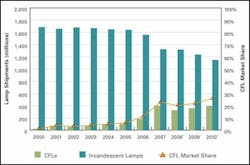For Replacement Lamps, LEDs are Different
VRINDA BHANDARKAR
Many energy efficiency programs have been promoting compact fluorescent lamps (CFLs) to reduce energy use. Rebates and discounts by major retail outlets have dramatically increased shipments of CFLs in the US — from 5% of the total lamps bought in 2004 to 23% in 2007. The US Environmental Protection Agency (EPA) estimates that Energy Star CFL sales for 2007 were nearly double those in 2006.
However, gains in efficient lighting have been fragile in the US. Sales of CFLs have dropped in the current recession to 21% of total US consumer light-bulb sales in 2008 from 23% in 2007, according to the US Department of Energy (See Figure 1). The steep decline in CFL shipments, even in regions that had invested in CFL promotions such as Vermont and Massachusetts, is a cause of concern to all who aspire to promote energy efficient lighting.
U.S. Lamp Shipments and CFL Market Share
There are many possible reasons for this decline in the market share of CFLs. New users have not been added to the market as disposable incomes have declined and customers are sensitive to higher prices Early adopters bought the long-lasting CFLs and the rest of the market has not followed suit Color quality issues of CFL persist and cannot be overcome with incentives Fear of mercury in CFLs has not been adequately addressed.
In order to promote energy savings, CFLs are heavily discounted or are being given away, and incandescent bulbs are scheduled to be banned in the U.S beginning in 2012 (they are already banned in Europe). In spite of heavy investment in promoting CFLs, incandescent technology has proved difficult to unseat, especially in the residential segment.
There is no publicly available data on the number of CFLs that are recycled, but in a report on CFL recycling programs around the world published in July 2009 by the Northeast Waste Management Officials’ Association (NEWMOA), CFL recycling rates vary from 87% in Taiwan (which includes all fluorescent) to 3% in 2004 in Canada. Only 2% of CFLs were recycled by German households in 2008. There is increasing evidence that efficient recycling of CFLs is going to require heavy investments in new infrastructure and public education.
Although CFLs were introduced in 1980s, they became a part of energy policy only in this century. If it had been left to the markets, CFLs would likely have made only a small dent in the market by now.
Today CFLs are the technology most closely associated with energy- efficient lighting, but LED lighting has started gaining mind share, at least in energy efficiency circles. The economic downturn has dampened the rate of the transition to efficient lighting technology. However, issues relating to global warming, energy security and environmental degradation are now a part of the public psyche. Although not many people have invested in efficient lighting, the awareness about efficient lighting options has increased. The LED lighting industry has continued to grow in spite of the economic downturn.
Since 2008, the price of HB LEDs has declined 10% to 25%. More LED manufacturing capacity has been created. The quality of white LEDs in terms of lumen output and CRI has improved. Warm white LED luminaires are comparable in terms of quality of light with incandescent lamps, but without their inefficiencies. However, the volumes have not yet reached critical levels at which the costs can be as competitive with CFLs.
There have been attempts around the world to design “demand pull” and “supply push” strategies for CFLs. The rate of penetration is directly proportional to the investments made in promoting CFLs. The outright ban on incandescents with distribution of free CFLs in Cuba has paid off. Similar strategies can be directed to LED applications that are ready to be pushed into the marketplace with no fear of releasing mercury. Moreover, LEDs can be used with controls that can offer further energy savings that are not possible using available CFL technology.
China has made developing LED technology one of its national priorities. It has embarked on the 21-city program, which will showcase LED applications, and it is expanding LED manufacturing clusters to seven regions. The grand experiment with LED streetlight installations is going through iterations, improving these products in the process.
Just three years ago LEDs were too dim for street lighting; in 2009 Los Angeles is installing 7,000 streetlights, with tens of thousands more planned for following years. There is an expectation that the problems relating to toxic material content, quality of light, and reliability of performance, like those encountered by CFL products, can be avoided by LED technology. There are agencies and organizations working to prevent those problems in spite of market pressures to flood the market with substandard products. This time it can be different.







